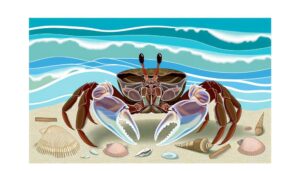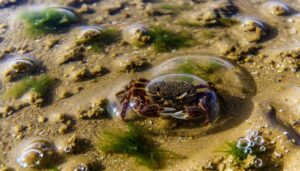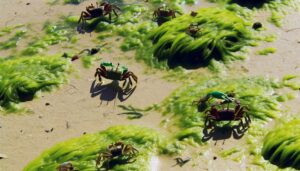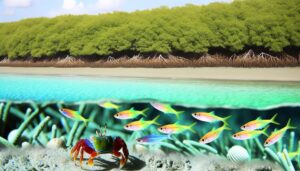Do Fiddler Crabs Need Land for the Perfect Habitat?
Fiddler crabs need brackish water environments to thrive, as these conditions support their complex osmoregulatory mechanisms, enhance metabolic efficiency, and provide essential nutrients. The ideal salinity range for these crabs is 15-25 ppt, as variations in salinity levels influence their habitat suitability and physiological well-being.
In freshwater, fiddler crabs experience significant osmoregulatory stress and reduced survival rates, while purely marine environments also impose undue physiological strain. As a result, recreating a brackish habitat using a marine salt mix is essential for their health and growth.
Discover how to maintain the best conditions and promote the well-being of fiddler crabs.
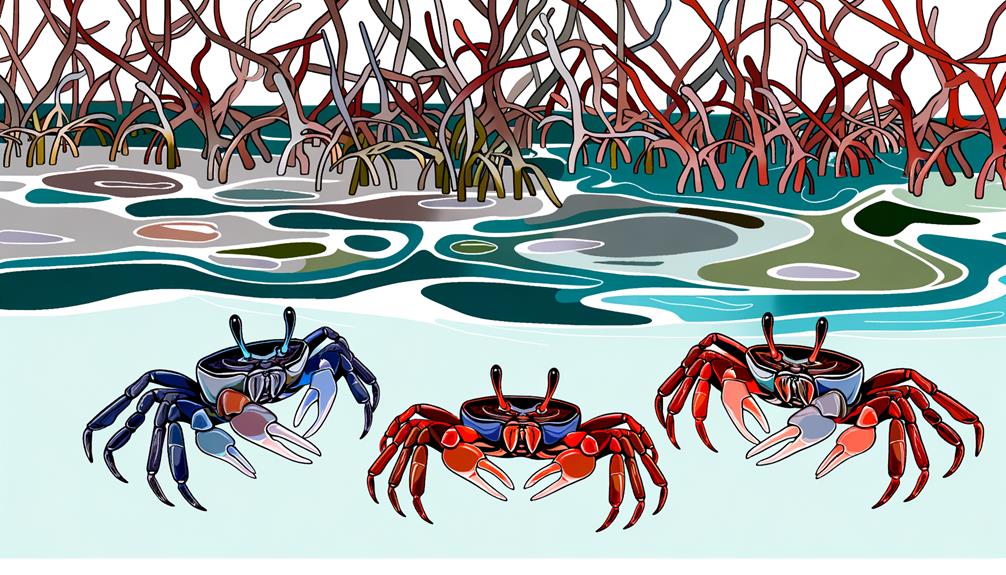
Key Takeaways
- Fiddler crabs thrive best in brackish water environments with salinity levels between 15-25 ppt.
- Brackish water supports essential osmoregulatory functions and reduces physiological stress in fiddler crabs.
- Survival rates and growth are optimal for fiddler crabs in brackish water conditions.
- Brackish water provides the necessary nutrients and stable habitat for fiddler crabs.
- Freshwater and marine water environments cause increased osmoregulatory stress and decreased survival for fiddler crabs.
Understanding Fiddler Crab Habitats
Understanding the natural habitats of fiddler crabs is crucial for optimizing their environmental conditions in captivity, as these crabs mostly thrive in brackish water ecosystems characterized by fluctuating salinity levels.
Fiddler crabs (Uca spp.) exhibit a marked preference for intertidal zones, where tidal movements induce dynamic changes in water salinity, ranging typically from 5 to 30 parts per thousand (ppt). These habitats provide essential resources such as sediment for burrowing and organic detritus for nutrition.
The physiological adaptations of fiddler crabs, including osmoregulatory mechanisms, enable them to tolerate and exploit these variable environments. Hence, replicating such conditions in captivity requires precise control of salinity gradients, sediment composition, and tidal simulation to guarantee their physiological and behavioral well-being.
Natural Habitat of Fiddler Crabs
Fiddler crabs mainly inhabit intertidal zones of estuarine environments, where they are subjected to constant fluctuations in salinity, sediment composition, and tidal dynamics. These dynamic habitats offer several important elements necessary for their survival and proliferation:
- Salinity Gradients: Varying salinity levels due to tidal movements foster physiological adaptability.
- Sediment Types: Diverse sediment compositions provide ideal conditions for burrowing and foraging.
- Tidal Cycles: Regular tidal inundations guarantee access to both aquatic and terrestrial resources.
- Vegetation Cover: Mangroves and marsh grasses offer protection and breeding sites.
These factors collectively create a complex, yet crucial, ecological niche that supports the unique life cycle of fiddler crabs, enabling them to thrive amidst environmental variability and challenges.
Water Salinity Explained
Water salinity is a critical parameter influencing the habitat suitability for fiddler crabs, requiring precise understanding and measurement to maintain best conditions.
Measuring water salinity typically involves the use of a refractometer or a hydrometer, both providing accurate readings essential for habitat management.
Elevated or diminished salinity levels can greatly impact marine life, affecting physiological processes and overall health.
Understanding Salinity Levels
Salinity levels, measured in parts per thousand (ppt), play a significant role in the physiological processes and habitat preferences of fiddler crabs. These crustaceans exhibit osmoregulatory adaptations that enable them to thrive in specific salinity ranges. Research indicates that best salinity conditions for fiddler crabs typically fall within the brackish water range, which balances the osmotic pressure between their internal fluids and the external environment.
Key salinity details for fiddler crabs:
- Ideal Range: 15-25 ppt is best for health and reproduction.
- Tolerance Limits: Can tolerate 10-35 ppt, but with varying stress levels.
- Osmoregulation: Efficient in maintaining internal homeostasis within the brackish range.
- Habitat Impact: Deviation from best salinity affects molting and metabolic functions.
Understanding these salinity parameters is necessary for ensuring the well-being of fiddler crabs in both natural and artificial habitats.
Measuring Water Salinity
Accurately measuring the salinity of water is essential for maintaining appropriate conditions for fiddler crabs, as it involves using specific tools and methodologies to achieve precise readings within their ideal range. Common tools include refractometers, hydrometers, and digital salinity meters, each offering varying degrees of accuracy and ease of use. Refractometers provide high precision by measuring light refraction through the water, whereas hydrometers gauge density changes. Digital salinity meters offer convenience through electronic readings. Proper calibration and regular maintenance of these instruments are necessary to ensure reliable data.
| Instrument | Principle of Operation | Accuracy Level |
|---|---|---|
| Refractometer | Light Refraction | High |
| Hydrometer | Density Measurement | Moderate |
| Digital Salinity Meter | Electronic Conductivity Measurement | High |
Understanding these methodologies allows for optimal aquatic environment management.
Impact on Marine Life
In marine ecosystems, the salinity of water significantly influences the physiological processes, habitat distribution, and overall health of marine life, including fiddler crabs. Variations in salinity can affect osmoregulation, enzyme function, and metabolic rates in aquatic organisms.
For fiddler crabs, maintaining an ideal salinity range is important for survival and reproduction. Studies indicate several key impacts of water salinity on marine life:
- Osmoregulation: Proper salinity levels are essential for maintaining internal fluid balance.
- Metabolic Activity: Enzyme efficiency and metabolic rate are salinity-dependent.
- Habitat Suitability: Salinity gradients determine the distribution of species.
- Reproductive Success: Salinity levels influence reproductive processes and offspring viability.
Understanding these factors is crucial for ecological conservation efforts and habitat management.
Role of Brackish Water
The role of brackish water is vital for the ecological balance and physiological functioning of fiddler crabs, as it provides a unique environment that supports their osmoregulatory processes. Brackish water, with its intermediate salinity, facilitates the crabs' ability to regulate internal salt and water concentrations, essential for their survival. This habitat also supports a diversity of microorganisms and detritus that form the crabs' diet.
| Aspect | Importance |
|---|---|
| Osmoregulation | Enables internal balance |
| Food Sources | Supports dietary needs |
| Habitat Stability | Fosters ecological balance |
Research indicates that fiddler crabs exhibit best growth rates and reproductive success in brackish conditions, underscoring the necessity of this habitat for maintaining their populations.
Fiddler Crabs in Freshwater
Shifting fiddler crabs from their natural brackish habitats to freshwater environments presents significant biological and ecological challenges. Evidence indicates that survival rates decrease markedly due to osmoregulatory stress, which impairs their physiological homeostasis.
Additionally, the adaptation mechanisms of these crabs remain insufficiently robust to counteract the adverse freshwater conditions, leading to increased mortality and compromised health.
Freshwater Environment Issues
Maintaining fiddler crabs in a freshwater environment often leads to significant physiological stress and increased mortality rates due to their inability to osmoregulate effectively outside of brackish conditions. This maladaptation can result in several vital issues:
- Impaired Ion Regulation: Fiddler crabs require a specific ionic balance, which freshwater fails to provide, leading to disrupted cellular functions.
- Dehydration: Freshwater environments can cause osmotic pressure imbalances, resulting in excessive water uptake and subsequent cellular dehydration.
- Weak Exoskeleton: The lack of essential salts and minerals in freshwater can impair exoskeleton hardening, making crabs more susceptible to injury.
- Metabolic Stress: Constantly adjusting to unsuitable environmental conditions increases metabolic demands, further straining the crab's physiological systems.
Understanding these challenges is essential for ensuring the health and longevity of fiddler crabs.
Survival Rate Concerns
Due to the inability of fiddler crabs to osmoregulate in freshwater environments, their survival rates plummet considerably, as evidenced by increased mortality statistics in controlled studies. Empirical data reveal that freshwater conditions induce osmotic stress, leading to lethal physiological imbalances.
These imbalances manifest through hyperhydration and subsequent cellular dysfunction, underscoring the crabs' physiological constraints. In a study published in the Journal of Experimental Marine Biology and Ecology, fiddler crabs exhibited a 70% mortality rate within 48 hours of freshwater exposure, compared to less than 10% in brackish conditions.
These findings clearly suggest that maintaining an ideal salinity level is crucial for their survival, with freshwater environments proving detrimental due to the crabs' intrinsic osmoregulatory limitations.
Adaptation Challenges
The adaptation challenges faced by fiddler crabs in freshwater environments arise primarily from their inability to effectively regulate internal osmotic pressure, leading to substantial physiological stress and impaired survival. This osmotic imbalance causes dehydration, ion loss, and energy depletion. Research indicates several specific challenges:
- Osmoregulation: Fiddler crabs struggle to maintain homeostasis in freshwater due to the lack of essential salts and minerals.
- Dehydration: Freshwater environments accelerate the loss of water from their bodies, causing severe dehydration.
- Energy Expenditure: Increased energy is required for osmoregulatory processes, diverting energy from growth and reproduction.
- Survival Rates: Studies show markedly lower survival rates in freshwater, with many crabs unable to acclimate effectively.
Understanding these challenges is essential for their conservation and habitat management.
Fiddler Crabs in Marine Water
Fiddler crabs exhibit significant physiological stress when exposed to marine water due to their osmoregulatory adaptations to brackish environments. The elevated salinity levels in marine water disrupt their internal ionic balance, leading to increased metabolic demands. Empirical studies indicate heightened mortality rates and reduced molting success under such conditions.
| Parameter | Marine Water Impact | Brackish Water Impact |
|---|---|---|
| Salinity Levels | High | Moderate |
| Osmoregulatory Stress | Elevated | Minimal |
| Metabolic Rate | Increased | Stable |
| Survival Rate | Decreased | Best |
In marine water, the crabs' gills must work harder to excrete excess salts, which diverts energy from growth and reproduction. Consequently, fiddler crabs are less likely to thrive in marine conditions, underscoring the need for environments that mimic their natural brackish habitats.
Benefits of Brackish Water
Ideal brackish water conditions provide a balanced salinity that minimizes osmoregulatory stress and supports the metabolic efficiency essential for the growth and survival of fiddler crabs. Scientific studies have shown that brackish environments facilitate best physiological functioning, thereby enhancing the overall well-being of these crustaceans.
The benefits of maintaining such conditions are numerous:
- Reduced Osmoregulatory Stress: Secures energy conservation by decreasing the physiological burden on the crabs.
- Enhanced Growth Rates: Promotes more efficient nutrient absorption and utilization.
- Improved Immune Function: Strengthens the immune response, reducing susceptibility to diseases.
- Reproductive Success: Fosters favorable breeding conditions, hence increasing reproductive output.
These advantages underscore the importance of brackish water in sustaining healthy fiddler crab populations.
Creating Brackish Water at Home
Creating a brackish water environment at home requires accurate salinity control and regular monitoring to achieve ideal conditions for fiddler crabs.
Begin by using marine salt mix, specifically designed for aquariums, to achieve a salinity range between 1.005 and 1.015 specific gravity. Utilize a hydrometer or refractometer to measure and maintain consistent salinity levels.
Prepare water by dissolving the salt mix in dechlorinated tap water, guaranteeing thorough mixing before introducing it to the tank. Gradually acclimate the crabs to the new environment to prevent osmotic shock.
Employ a reliable filtration system to manage waste and stabilize water parameters. Regularly test water parameters for salinity, pH (7.5-8.5), and temperature (75-85°F) to ensure the best possible living conditions.
Monitoring Water Quality
Ensuring supreme water quality for fiddler crabs necessitates rigorous and systematic monitoring of key parameters such as salinity, pH, and temperature. Accurate and consistent measurement of these variables is critical to maintaining an ideal habitat.
- Salinity: Use a refractometer to maintain salinity within 1.005 and 1.015 specific gravity units.
- pH Levels: Maintain pH between 7.5 and 8.5 using a digital pH meter, as deviations can stress the crabs.
- Temperature: Keep water temperature stable between 75°F and 85°F, monitored by a reliable aquarium thermometer.
- Ammonia Levels: Regularly test for ammonia levels using an appropriate test kit to prevent toxic build-up.
Implementing these monitoring practices ensures a stable, healthy environment for fiddler crabs.
Conclusion
In the intricate dance of ecosystems, fiddler crabs emerge as symphonic conductors, thriving in the harmonious blend of freshwater and saltwater domains. Brackish water, the confluence of these opposing forces, provides the best milieu for their survival.
Freshwater and marine environments, by contrast, offer discordant notes that disrupt their physiological equilibrium. Consequently, the creation and meticulous maintenance of brackish water habitat serve as the keystones for ensuring the well-being and sustainability of fiddler crab populations.


